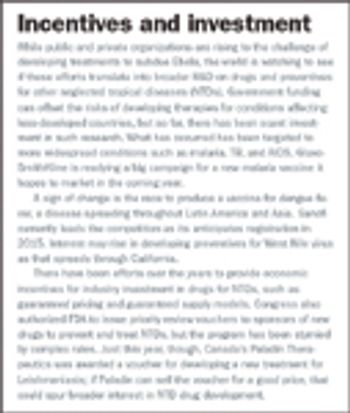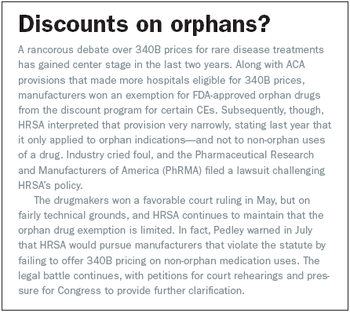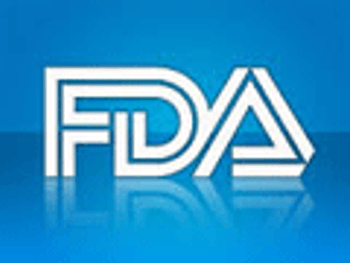
The federal Open Payments program has gone live, but biopharma companies continue to be concerned about the lack of context. Jill Wechsler reports.
Jill Wechsler is Pharm Exec's Washington Corespondent

The federal Open Payments program has gone live, but biopharma companies continue to be concerned about the lack of context. Jill Wechsler reports.

Companies gain support-and pressure-to deliver new treatments for spreading outbreak.

FDA’s Center for Drug Evaluation and Research is establishing an Emerging Technology Team (ETT) to assist innovative manufacturers in navigating the regulatory process and “overcoming roadblocks”.

Although biopharmaceutical companies and regulatory authorities have made considerable progress in establishing policies for bringing biosimilars to market, key differences and gaps in requirements for testing and documenting product similarity still characterize the European Union, the U.S. and other regions.

Up until a few months ago, there was little industry interest or public support for developing vaccines and treatments to combat the Ebola virus.

Expansion of drug discount program ignites lawsuits, policy disputes.

Further delays in implementing the Open Payments program for disclosing industry financial relationships with prescribers has ignited a blame-game over who is at fault.

Two years into the Generic Drug User Fee Act (GDUFA) program, enacted in July 2012, FDA officials are striving to meet goals and timelines for speeding new generic drugs to market.

FDA has been rolling out new guidelines for using interactive media in recent months. The new guidances clarify some murky areas, but may not make online communications any easier.

Tweeting limited, corrections okay, says FDA, as industry, regulators wrestle with the digital world. Our Washington Correspondent Jill Wechsler reports.

After months of speculation about prospects for biosimilar development in the U.S., Novartis announced July 24 that FDA has accepted Sandoz’ biologics license application (BLA) for a similar version of Amgen’s Neupogen (filgrastim).

Pharma backs federal standards for compassionate use, drug importing, data transparency, and track-and-trace. Jill Wechsler reports.

A potential treatment for sickle cell disease has come through the “valley of death” of early stage development due to support from a collaborative partnership established by the National Center for Advancing Translational Sciences (NCATS) at the National Institutes of Health (NIH).

Beginning Jan. 1, 2015, manufacturers and distributors will need to have in place systems able to transmit information on prescription drug movement in the United States from plant,

Key to accelerating the discovery and development of new medical therapies is to improve the clinical research process, according to leaders of biopharmaceutical research community.

One piece of fall-out from the recent Hobby Lobby decision by the U.S. Supreme Court is to generate talk of Republicans backing development of a nonprescription contraceptive pill.

At the annual meeting of the Food and Drug Law Institute (FDLI) this year, FDA commissioner Margaret Hamburg concluded her keynote address by describing a “dramatically changing global marketplace” and its “huge implications” for FDA’s ability to ensure the safety and quality of products manufactured elsewhere.

Payers are seeking clear assessment of drug value to rationalize high drug prices. This issue has moved to center stage due to mounting concern over the high price for Gilead's Sovaldi, writes Jill Wechsler.

The Rx360 pharmaceutical supply chain consortium celebrated its first five years with an anniversary conference on June 5 in Washington, D.C.

The Obama administration received a substantial amount of good news last month.

Despite provisions in the Affordable Care Act that require qualified health plans to cover 'basic' benefits, access to prescription drugs may be limited by high out-of-pocket costs and tight pharmacy management strategies.

Vaccine development is on a roll, boosted by biomedical research uncovering new molecular targets for preventives and treatments.

Several legal cases have challenged the Food and Drug Administration’s approach to regulating industry communications about medical products.

In anticipation of the 200th anniversary of the United States Pharmacopeia (USP) in 2020.

A national publicity campaign recently succeeded in obtaining early access to an experimental treatment for a seriously ill child,

The recently released Medicare data on payments to individual doctors doesn’t provide specifics on prescription drug outlays,

A number of top management positions at the Center for Drug Evaluation and Research (CDER) need to be filled.

As payers demand more evidence documenting medical product value, biopharma companies are responding by moving sooner to decide key clinical outcomes to measure.

Accelerated testing and production create challenges in documenting product quality, writes Jill Wechsler.

The shift to personalized medicine, which supports medical treatment tailored to individual patient characteristics, has been hindered by uncertainty over the value, accuracy and clinical utility of companion diagnostic tests.